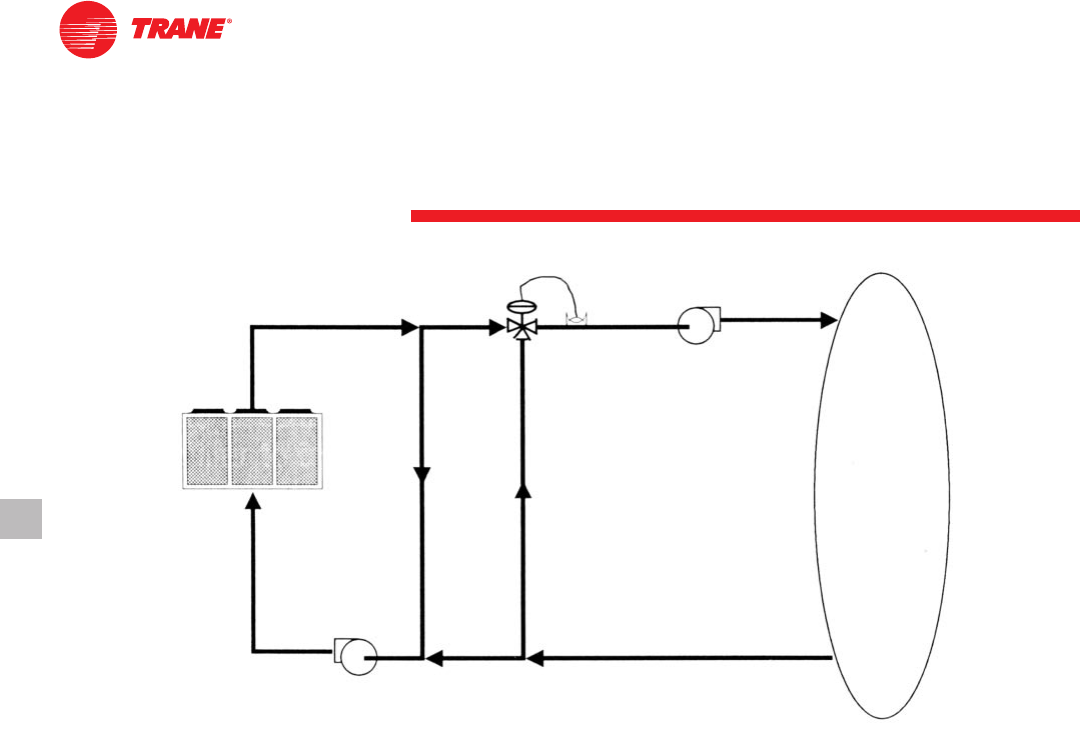
Application Considerations
10
RLC-PRC005-E4
15.6°C
7.6 Lps
21°C
7.6 Lps
CV Pump
15°C
5.4 Lps
35°C
5.4 Lps
35°C
7.6 Lps
29.4°C
7.6 Lps
15.6°C
2.2 Lps
35°C
2.2 Lps
Figure 5 — GPM Out of Range
Leaving-Water Temperature Range
Trane air-cooled Series R chillers have
three distinct leaving-water categories:
standard, low temperature, and ice
making. The standard leaving-solution
temperature range is 4.4 to 15.6°C [40 to
60°F]. Low-temperature machines
produce leaving-liquid temperatures
less than 4.4°C [40°F]. Since liquid
supply temperature set points less than
4.4°C [40°F] result in suction
temperatures at or below the freezing
point of water, a glycol solution is
required for all low-temperature
machines. Ice-making machines have a
leaving-liquid temperature range of -6.7
to 15.6°C [20 to 60°F]. Ice-making
controls include dual set point controls
and safeties for ice making and standard
cooling capabilities. Consult your local
Trane sales engineer for applications or
selections involving low temperature or
ice making machines. The maximum
water temperature that can be circulated
through an evaporator when the unit is
not operating is 42°C [108°F].
Leaving-Water Temperature
Out of Range
Similar to the flow rates above, many
process cooling jobs require
temperature ranges that cannot be met
with the minimum and maximum
published values for the Model RTAC
evaporator. A simple piping change can
alleviate this problem. For example: a
laboratory load requires 7.6 Lps [120
gpm] of water entering the process at
29.4°C [85°F] and returning at 35°C
[95°F]. The accuracy required is higher
than the cooling tower can give. The
selected chiller has adequate capacity,
but has a maximum leaving-chilled-
water temperature of 15.6°C [60°F].
In the example shown, both the chiller and
process flow rates are equal. This is not
necessary. For example, if the chiller had a
higher flow rate, there would be more water
bypassing and mixing with warm water.
Supply-Water Temperature Drop
The performance data for the Trane air-
cooled Series R chiller is based on a
chilled-water temperature drop of 6°C
[10.8°F]. Chilled-water temperature
drops from 3.3 to 10°C [6 to 18°F] may
be used as long as minimum and
maximum water temperature, and
minimum and maximum flow rates, are
not violated. Temperature drops outside
this range are beyond the optimum
range for control, and may adversely
affect the microcomputer’s ability to
maintain an acceptable supply-water
temperature range. Further, temperature
drops of less than 3.3°C [6°F] may result
in inadequate refrigerant superheat.
Sufficient superheat is always a primary
concern in any direct-expansion
refrigerant system and is especially
important in a package chiller where the
evaporator is closely coupled to the
compressor. When temperature drops
are less than 3.3°C [6°F], an evaporator
runaround loop may be required.
Load
CV Pump


















